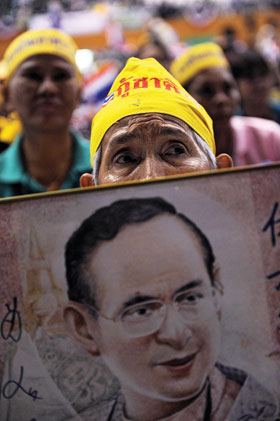YESTERDAY, Thai media reported that Prime Minister Abhisit Vejjajiva and nationalist Yellow Shirt leaders had reached a “common position” on the 4.6-square kilometre disputed area adjacent to Preah Vihear temple. In a televised debate with the so-called Thai Patriots Network, a fringe group dominated by the yellow-shirted People’s Alliance for Democracy, Abhisit agreed that the disputed area belonged to Thailand, and that Cambodians had “encroached” on Thai land.

An elderly Thai woman holds a portrait of Thai King Bhumibol Adulyadej as she listens to speakers during a Yellow Shirt rally in Bangkok. (Photo: AFP)
During Sunday’s debate, Veera Somkwamkid, leader of the network, called on the government to revoke the memorandum of understanding on border demarcation that Thailand signed with Cambodia in 2000. A day earlier, The Nation newspaper reported, Abhisit told a rally of Yellow Shirts that he would be willing to trash the MoU and openly considered using “military means” in order to safeguard Thai sovereignty.
At the debate, however, he softened his stance, saying that preserving the MoU was in Thailand’s best interests, and that military force was a “last option”.
The fact that Abhisit eventually backed away from the confrontational stance advocated by the Thai Patriots gives little reason to hope for a solution to the border dispute that has captivated the two countries since July 2008, when the United Nations Educational, Scientific and Cultural Organisation listed Preah Vihear as a World Heritage site. Indeed, the Thai leader’s prevarications encapsulate Bangkok’s peculiar bind: how to pursue a rational solution to the border dispute while contending with the demands of the PAD demagogues who swept the government to power in 2008.
Pavin Chachavalpongpun, a fellow at Singapore’s Institute of Southeast Asian Studies, said that after using “irrational nationalism” and mass Yellow Shirt protests to unseat former Prime Minister Thaksin Shinawatra and his proxies, the government was experiencing great difficulty putting the yellow genie back in the bottle. As a result, he said, Abhisit has “lost legitimacy to deal with the [temple] issue without any political implication”.
“For Thailand, the danger lies in the fact that the Yellow Shirts, taking the same position adopted by the government, can aggravate the situation,” Pavin said. “How will Abhisit make sure that nationalism can be used at the appropriate dose?”
No end in sight
Following another round of sparring over Preah Vihear at the UNESCO World Heritage Committee meeting in Brazil earlier this month, a solution to the temple dispute appears as remote as it did two years ago. With the Thai government now struggling to appease its own nationalist support base, analysts predict that the temple issue will continue to sour relations between Phnom Penh and Bangkok as long as the Thai crisis continues – that is, for the foreseeable future.
Puangthong Pawakapan, a specialist in Thai-Cambodian relations at Bangkok’s Chulalongkorn University, said that even a handover of power at next year’s Thai elections could be stymied by continuing Yellow Shirt “misinformation” about the Preah Vihear issue. Given that the temple issue was used by the PAD to force the resignation of former foreign minister Noppadon Pattama in 2008, she said, Thai governments of all complexions will be wary of giving ground. “This implies”, she added, “that even in the next election when the pro-Thaksin party might become a government, they will not dare to be friendly … with Cambodia.”
It takes two to tango
Cambodian actions have also deepened the dispute. Ou Virak, president of the Cambodian Centre for Human Rights, said Prime Minister Hun Sen’s own use of the Preah Vihear issue as an electoral tactic in 2008 had fuelled a dispute that he now “does not know how to stop”. He described the appointment of Thaksin as an economic adviser as a “mistake” that had allowed Thai nationalists to put a further obstacle in the way of a negotiated solution. Ou Virak said Hun Sen’s call for the creation of an international conference to settle the border dispute, made in a speech yesterday, was “long overdue”, but Thailand has long opposed a multilateral solution.
Others said Cambodia and Thailand could benefit from taking a more creative approach to the border dispute. In an article in the Bangkok Post yesterday, Morakot Meyer from Srinakharinwirot University in Bangkok said the two countries should look to Germany and Poland, which turned a border zone into a shared heritage site. Puangthong said similarly that Phnom Penh and Bangkok should jointly submit the 4.6-square kilometre disputed zone to UNESCO and develop the area as a “peace park”.
She said such a solution, denounced as “treason” by the Thai nationalist fringe, could be the last chance to prevent an international settlement that, following the 1962 World Court ruling that handed Preah Vihear temple to Cambodia, would likely turn out in Phnom Penh’s favour. Such an outcome would “cause an upheaval in Thailand and thus worsen Thai-Cambodian relations”, she said.
“But the Abhisit government never cares to listen to different views,” she added. “He has been playing with nationalist fire ever since he was an opposition leader.”
]Published in the Phnom Penh Post, August 10, 2010]



